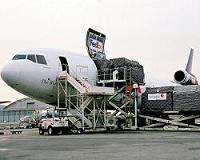Growth in world air freight volumes will slow during the 2007-2011 period due to strongercompetition from other transport modes such as shipping, according to a new forecast released by
IATA yesterday. Trade imbalances are also an area for concern, according to the report.The international airline association predicted that international freight volumes would growat an AAGR of 4.8% over the next four years, driven by economic growth, globalisation and trade.
But strong price competition from other modes of transport is expected to keep freight demandgrowth below the 6.2% AAGR recorded for 2002-2006, IATA pointed out. In 2011, some 36 milliontonnes of international freight are forecast compared to about 28.5 million tonnes in 2006.
Express freight figures were not specifically included in the study. But Boeing haspreviously forecast that high-value express freight will increase its share of the overall airfreight market dramatically in future, increasing to about 30% of total volumes from the present 9%level.
At a regional level, Asia Pacific is expected to lead freight growth with an AAGR of 5.4%over the 2007-2011 period, IATA said. Seven of the top ten growth markets fall within the region:China (10.8%), India (8.3%), Republic of Korea (8.2%), Vietnam (7.5%), Sri Lanka (6.8%), Pakistan(6.7%) and Malaysia (6.2%). The Middle East will see the second highest growth at 5.0%. The fastestgrowing Middle Eastern markets are expected to be Qatar (6.9%) and Saudi Arabia (6.2%).
Freight to/from and within Asia Pacific will account for 57% of the 36 million tonnes ofinternational air freight volume in 2011, up from 55% in 2006. The other main international airfreight regions in 2011 in terms of market share will be Europe-North America (12%), intra-Europe(6%) and North America-Latin America (5%), according to the IATA report.
As most volume will be outbound from Asia, there are concerns about the impact of imbalancesin global trade patterns on the industry, IATA pointed out. There is significantly higher demand onthe outbound leg from Asia than on the return leg, and airlines are having to seek new cargo typesor to have multiple stops on the return leg in order to improve return load factors, the airlineassociation noted.
Meanwhile, international passenger demand is expected to rise from 760 million passengers in2006 to 980 million in 2011 at an annual average growth rate (AAGR) of 5.1%, according to IATA.This will be lower than the 7.4% AAGR recorded during 2002-2006, largely due to slightly slowerglobal economic growth.
The main passenger growth markets will be the Middle East and Asia (China and India inparticular) while Europe will have moderate growth, and Latin America and North America relativelylow growth.
“The numbers clearly show that the world wants to fly. And it also needs to fly. Airtransport is critical to the fabric of the global economy, playing a critical role in wealthgeneration and poverty reduction. The livelihoods of 32 million people are tied to aviation,accounting for US$3.5 trillion in economic activity,” said Giovanni Bisignani, IATA’s DirectorGeneral and CEO.
IATA also said it has a clear four pillar strategy to take aviation to carbon neutral growthin the medium term, based on investment in technology, more effective operations, efficientinfrastructure and appropriate economic measures. “The growing demand for aviation is anopportunity for sound investment in a green future,” said Bisignani.
IATA, which represents some 240 airlines comprising 94% of international scheduled airtraffic, said that the traffic forecast is based on a comprehensive survey of airline expectationsfor major route areas.












